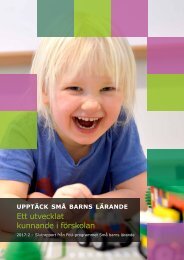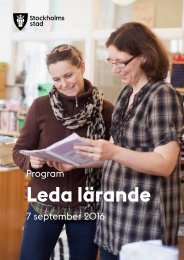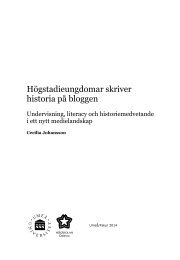FULLTEXT02
FULLTEXT02
FULLTEXT02
Create successful ePaper yourself
Turn your PDF publications into a flip-book with our unique Google optimized e-Paper software.
Using the figure below, I would like to try to illustrate the various levels<br />
in a session.<br />
Values<br />
Theories<br />
Experience<br />
Figure 13. Different levels in a mentor session<br />
The content of the figure helps supervisors when they switch levels in a<br />
conversation. If a supervisor involved in guiding the conversation begins<br />
with describing a situation that makes participants anxious, maybe others<br />
could "add" different input that almost describes the same thing. If the<br />
supervisor then asks the question "How is it that you choose to do as you<br />
do" or "How do you know that the way you do today is the best way to<br />
act" the conversation can open up for reflection, which in turn implies<br />
that the theories and values can be woven into the conversation.<br />
The figure is partly inspired by Handal and Lauvås reasoning around<br />
teachers' practical vocational theory, which is based on three components:<br />
personal experience, theories and values. This context refers to the<br />
“practice-triangle" of Lovlie, in which educational practice is illustrated<br />
with the help of a triangle divided into three levels: an action level, a<br />
mental level (planning and reflection) and an ethical level (ethical considerations)<br />
(Lauvås & Handal, 1982).<br />
In my analysis of conversational patterns, I have also tried to see (3) in<br />
which direction the talks evolve during mentor sessions, and to what extent<br />
they change character to deepen and lead the supervisors to develop<br />
new perspectives and ways of looking at their role. For a session to be<br />
able to integrate thought and action, the mentor must challenge the<br />
group’s thoughts about and descriptions of their practices by offering<br />
resistance. To be able to ask questions that are challenging and developing<br />
it helps if the supervisors are aware of and have taken a position on<br />
how they perceive children’s learning, teacher's roles and the purpose of<br />
the pre-school. Otherwise, there is great risk that the supervisor's own<br />
desire to participate in the conversation colors the questions posed.<br />
The reflections of supervisors about the conversations have been divided<br />
into different categories based on how the talks developed. I have<br />
134





